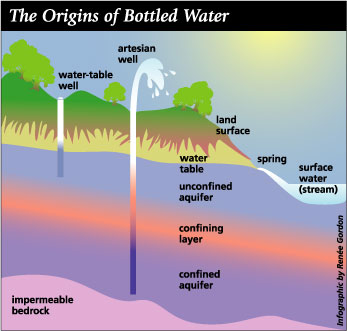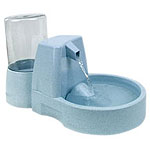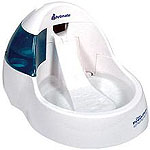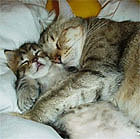Vol. 1, No. 42
Table of Contents
Assist Feeding – Water Quality
Feline Nutrition – Weight Loss
Pro-Active Cat Care – Small Pleasures
Feline Obesity – The Importance of Water
Kitty Potpourri – Why is Kitty’s “Motor” Running?, Part I
Assist Feeding – Water Quality
by Kathy Fatheree
Last week we talked about water bowls. but what about the water itself?
When we have a sick kitty, we ask the question.
What is the best kind of water to give my kitty?
I live in an area where the water is really hard. Most people have water softeners, but I wonder what is worse. the high calcium levels. or the higher salt level due to the water softener. Water softeners are available that use potassium, but they slightly elevate the potassium level in the drinking water.
Should we buy bottled water for our furry friends? But then we hear all the stories about how bottle water sometimes is not as pure as we think and drinking tap water is at times purer.
Distilled water is touted the purest and it is more alkaline and better for the body, however, the distillation process removes all the minerals so it is imperative to add mineral drops to the water.
Such a dilemma!
Water Filters is just what it sounds like. a system that has some kind of filter to trap different size particles. A reverse osmosis system is probably the best and of course, is the more expensive. However, this kind of filter does not guarantee purity from bacteria, viruses and other living organisms. it only removes particles of certain sizes.
Water Purification Systems kill bacteria and viruses that may sneak through. An example of a water purifier is a system that uses Ultra Violet light. However, this system allows unwanted particles to sneak through.
The web site WaterFilterComparisons.net states:
The healthiest water is produced by “selective filtration”, products that have the ability to remove contaminants and not minerals.
So this would mean some kind of combination filter.
The FDA web site has a great article titled “Bottled Water: Better Than the Tap?”
Listed below are the descriptions from this article about 4 different kinds of water treatment:
- Distillation. In this process, water is turned into a vapor. Since minerals are too heavy to vaporize, they are left behind, and the vapors are condensed into water again.
- Reverse osmosis. Water is forced through membranes to remove minerals in the water.
- Absolute 1 micron filtration. Water flows through filters that remove particles larger than one micron in size, such as Cryptosporidium, a parasitic protozoan.
- Ozonation. Bottlers of all types of waters typically use ozone gas, an antimicrobial agent, to disinfect the water instead of chlorine, since chlorine can leave residual taste and odor to the water.
Furthermore, this article explains the different types of bottled water. I know I’ve always wondered what the differences were. The image below is from the FDA web site.

- Artesian well water. Water from a well that taps an aquifer–layers of porous rock, sand and earth that contain water–which is under pressure from surrounding upper layers of rock or clay. When tapped, the pressure in the aquifer, commonly called artesian pressure, pushes the water above the level of the aquifer, sometimes to the surface. Other means may be used to help bring the water to the surface. According to the EPA, water from artesian aquifers often is more pure because the confining layers of rock and clay impede the movement of contamination. However, despite the claims of some bottlers, there is no guarantee that artesian waters are any cleaner than ground water from an unconfined aquifer, the EPA says.
- Mineral water. Water from an underground source that contains at least 250 parts per million total dissolved solids. Minerals and trace elements must come from the source of the underground water. They cannot be added later.
- Spring water. Derived from an underground formation from which water flows naturally to the earth’s surface. Spring water must be collected only at the spring or through a borehole tapping the underground formation feeding the spring. If some external force is used to collect the water through a borehole, the water must have the same composition and quality as the water that naturally flows to the surface.
- Well water. Water from a hole bored or drilled into the ground, which taps into an aquifer.
Determining the absolute best water for your kitty is a research-intensive project. There are so many factors to consider. If you have time to do your research, get on the Internet and read as much as your can to educate yourself. Don’t let all the variables overwhelm you, just continue to read until you start to understand it all. If you are crunched for time and have a sick kitty who you are assist feeding, ask your vet if the water in your local area contains minerals and/or organisms that may be detrimental to your kitty.
If you are uncomfortable with the water that you are giving your kitty, you may want to:
- Have water delivered from reputable company, however, ask where the water comes from and what benefits does it have over the water in your house. Don’t take their word for it that it’s the best in town. do your homework.
- Buy the best water purification/water filter combination system you can find.
On the Net:
Water Filter General Information
FDA Article “Bottled Water: Better Than the Tap?”
Do you use a Water Purification System?
Email me at: Feedback(at)AssistFeed.com
Feline Nutrition – Weight Loss
by Garry White
A situation arose recently on one of the feline lists I sometimes frequent. A particular kitty was diagnosed with CRF a few months ago, and of course the vet prescribed a food specific to that ailment. However, the kitty has gone from 14 pounds, down to 9-something in these few months. Not good, and certainly not acceptable. If this continues, the kitty is likely facing Hepatic Lipidosis (fatty liver disease) to go along with the CRF.and I can’t imagine a worse scenario than that.
But let us not scream at the caregiver: She seems to have tremendous faith in her vet, and she’s doing exactly what he told her to do.make sure the kitty has one full can of this food every day. So, by hook and by crook, one whole can of this food is going inside the kitty, and supposedly staying there, and yet Kitty is losing weight in big numbers.
Here’s why: Good vet or not, he missed the target. According to the manufacturer of that food (and two other manufacturers, by the way), there is a general guideline, and I’ll emphasize that this number can change with age and condition of the cat. It doesn’t apply to 6-ounce newborn kittens, nor to extremely older (or extremely large) cats, but for a middle-of-the-road, average age/weight cat, the daily requirement is about 27.5 k/cal (calories) per pound of cat-weight. Meaning her 14-pound kitty should have been getting about 385 calories per day, and the particular food prescribed is 234 calories per 5.5 ounce can, which means that the kitty should have been eating 1.65 cans of the stuff daily. But the vet prescribed one can per day, which missed the actual requirement by more than 50-percent!
Some errors are tolerable, but this one surely is not, and especially not with a sick cat who needs every possible edge that can be afforded. It’s all in those tiny numbers, and it’s why I encourage our readers so emphatically to get technically involved with issues of nutrition. Typically, following a vet’s advice is the right thing to do, but in this case it shortchanged a sick kitty of more than half of the nutrition it needs so very badly.
So what do we do? Do we ignore the vet? No, we do not. We take his numbers, and then we go home and confirm them. It took me less than a minute on the phone (with the manufacturer) to identify why this kitty is losing weight, and maybe another minute to do the math. You be the judge as to whether or not we should be doing this as a simple matter of routine.
ProActive Cat Care – Small Pleasures
by Garry White

Feline Obesity – The Importance of Water
by Kathy Fatheree
We all know that we should drink more water. You hear it all the time.eight glasses a day. But how many of us do that?
It makes me wonder if the Obese Cat is drinking enough water, too. After all, my fat cat is a little bit lazy and it may be just as easy for her to not drink as it is for me!
Water has many benefits and these apply to cats as well:
- Water helps to flush toxins from the body. When a cat is obese, many toxins are stored in the fat. Extra water is needed to flush the toxins out of the fat cells. If the body is not properly hydrated, it will be more difficult for the kidneys and liver to do their job.
- Proper hydration ensures that the hunger / full mechanisms are working properly. Why does a fat cat eat all the time? When the body is dehydrated, the feeling of dehydration is mistaken as the feeling of hunger. Drinking more water will get the signals working properly again.
- Dehydration causes fatigue. Perhaps if kitty is properly hydrated, he or she will be more energetic?
- Most fat cats have joint aches due to the excess weight they are carrying around.
- Drinking extra water will help keep joints healthy and hydrated and ease the pain.
- Water is alkaline and some studies suggest that keeping the body more alkaline may help the body to fight cancer.
How can you encourage your cats to drink more water?
What’s that saying “You can lead a horse to water but you can’t make it drink”. You can lead a cat to water.
Here are some Water Drinking Tips:
- Keep several water bowls in your cat’s favorite places.
- Make sure the water bowl is fresh, clean and full everyday.
- Use a water bowl that your cat enjoys drinking out of. My cat Maya will drink only if the bowl is filled to the brim!
- Purchase a pet drinking fountain such as the ones shown below:
Drinkwell Fresh Water Fountain and Reservoir:
Petmate Fresh Flow Pet Fountain for Cats:

Kitty Potpourri – Why is Kitty’s “Motor” Running?, Part I
by Dan Malenski
This week, we will start a two part series that will talk about how cats purr and the many reasons why they do so. This week, we will focus on how our cats produce the sound in their bodies and why they do so. Next week, we will talk about how their purring helps us and a company’s efforts to “bottle” and sell it; so, be sure to visit us next week for Part II. We all worked on gathering information for this week’s article from many sources on the internet and the Catwatch® newsletter.
To this day, many theories exist regarding how our feline companions create the purring sound in their bodies, and the answer depends on whom you ask! The only thing that they seem to agree on is that the sound is produced on both inhalation and exhalation and at a frequency between 25-150 Hertz (Hertz is the modern term for cycles per second). There are many theories that attempt to explain precisely how the cat produces the sound within their bodies, and theories are constantly falling out of favor and replaced by others over time.
The purring in a cat is a continuous sound, not a deliberate one like a “Meow” and does not require the cat to open its mouth. One can also observe that the purr occurs in tandem with a vibration on the cat’s body, particularly in the area of the mouth and nose, although it does not originate there.
Some of the theories for the sound presented in the past are vibrations of the palate at the back of the cat’s mouth, movement of air through the diaphragm,  and blood flowing through a vein in the cat’s chest causing vibrations. The leading theory at this time, which is subject to change, is that the sound is produced by the interaction of muscles in the larynx and the diaphragm. This may explain why there is so much confusion about how cat’s (and other feline creatures) produce the sound. Many researchers had focused on a single source, when there are actually multiple sources involved. Amanda chimed in while I was typing this and said that she could have told them that when she was a kitten!
and blood flowing through a vein in the cat’s chest causing vibrations. The leading theory at this time, which is subject to change, is that the sound is produced by the interaction of muscles in the larynx and the diaphragm. This may explain why there is so much confusion about how cat’s (and other feline creatures) produce the sound. Many researchers had focused on a single source, when there are actually multiple sources involved. Amanda chimed in while I was typing this and said that she could have told them that when she was a kitten!
Most of us believe that cats purr when they are contented, such as when curled up in your lap or while nursing from their loving mother. This is true, but other reasons exist why cats purr, and the most beneficial, at least for the cat, are those that promote healing. Cats will purr when they are injured, anxious, ill, or even during encounters with the opposite sex! It is now widely believed that purring in cats helps in the relief of pain and the healing of injured bones and muscles. Researchers believe that the low frequency sound  energy is responsible for the healing, which is much the same as used in many sports medicine programs for us. There are many studies that compared the healing time between dogs and cats, and while it is impossible provide any actual data due to the large number of variables involved, over the long term, cats have always appeared to heal quicker.
energy is responsible for the healing, which is much the same as used in many sports medicine programs for us. There are many studies that compared the healing time between dogs and cats, and while it is impossible provide any actual data due to the large number of variables involved, over the long term, cats have always appeared to heal quicker.
We all know that the sound of a cat purring has a calming effect on us humans, and now we know that your cat is also a beneficiary, and in many ways. We don’t have to lecture anyone here as to how much our cat’s purring can soothe our frazzled nerves, and this has obviously caught the attention of the folks in the commercial industry who are now working hard to bottle and sell it. Amanda has that puzzled look on her face, and we will all find out how they are going to do it next week.
Disclaimer: Kathy Fatheree is not at all a medical expert. Contents of this web site are a collection of Kathy’s assist feeding experiences as well as the experiences of other cat owners who have assist fed their cats. While every effort has been made to ensure the accuracy of the information, Kathy Fatheree or anyone associated with this web site cannot be held responsible for anything that may happen as a result of using the information on this site.
